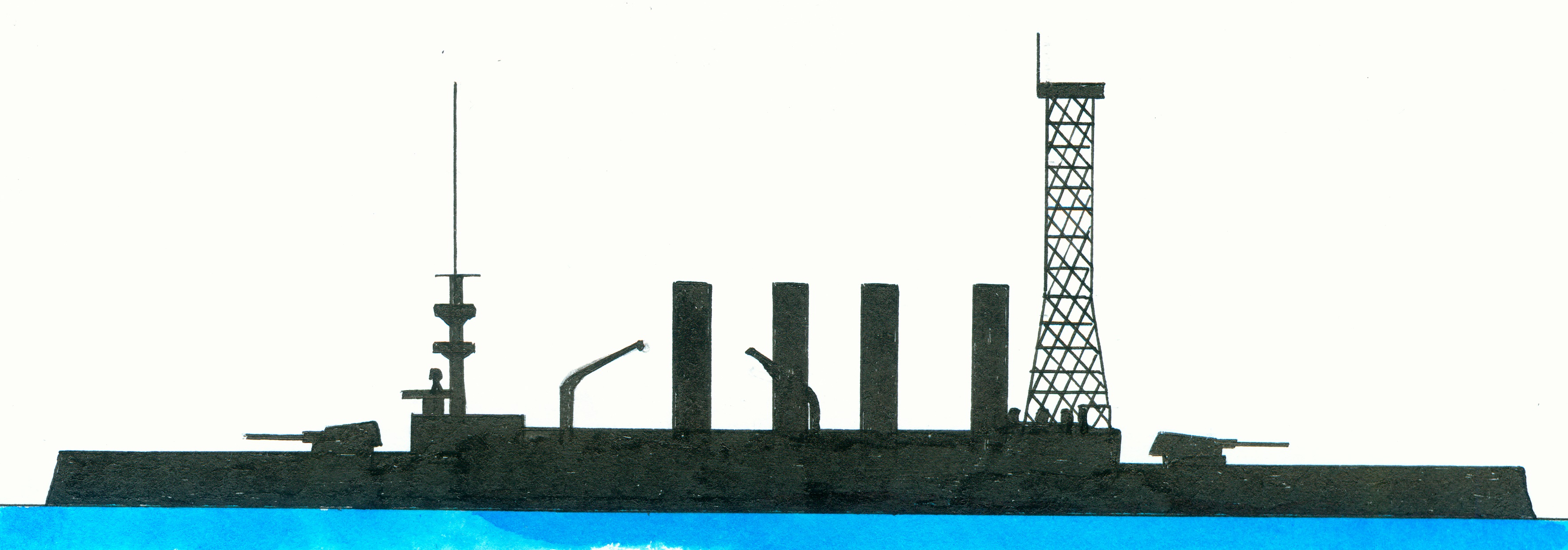USS Brooklyn
Pennsylvania-class
Tennessee-class
Of the Pennsylvania-class consisting o the Pennsylvania (renamed Pittsburgh), West Virginia (renamed Huntington), California (renamed San Diego), Colorado (renamed Pueblo), Maryland (renamed Frederick) and South Dakota (renamed Huron). Built under the fiscal years 1900-1901. Preceded by the USS Brooklyn (ACR-3) and succeeded by the Tennessee-class. The considered modernisation in 1922-1923 of the Pennsylvania-class is never executed. It included new boilers and engines resulting in an increased speed of 25-27 knots, better protection and the new 3-20,3cm/8”/55 cal gun turrets. Also known as Armored Cruiser No. 5. Building ordered on 3 March 1899, approved on 24 January 1901, laid down by Newport News Drydock&Shipbuilding Co., Newport News, Virginia, USA on 16 September 1901, baptized by Miss Katherine V. White, launched on 18 April 1903, commissioned on 23 February 1905, fitted out with catapult devices on the quarterdeck and accommodation for 4 seaplanes on the boat deck ways, renamed Huntington on 11 November 1916,added to the Naval Air Station at Pensacola for tests with balloons and seaplanes launched from her deck in June-July 1917. Converted into a troop transport in 1918, decommissioned on 1 September 1920, stricken on 12 March 1930 and sold to be broken up on 30 August 1930. Contracted building costs for hull and machinery 3.885.000 US dollars. Pennant numbers ACR-5 and CA-5.
Displacement 13.900 (standard)-15.381 (full load) tons and as dimensions 153 (between perpendiculars)-153,59 (over all) x 21,18 x 7,34 (mean) metres or 502-503.11’ x 69.6’x 24.1’. The machinery consisted of 2 vertical inverted triple expansion steam engines and 16 Babcock&Wilcox-boilers supplying 23.000 ihp (design) driving 2 screws allowing a speed of 22-22,15 (trials) knots. Coal bunker capacity 900 (normal)-2.000 (maximum) tons. Her crew numbered 830 men. The armour consisted of a 13/5” (bottom)-15.6“ (top and waterline) thick belt, a 3,8cm/1.5” (flat)-10,2cm/4” (slope) deck with the turrets, barbettes and conning tower protected by respectively 16,5cm/6.5”, 15cm/6” and 22,9cm/9” thick armour. The original armament consisted of 2x2-20,3cm/8” /40 cal Mark 5 guns, 14-15,2cm/6” /50 cal Mark 6 guns, 18-7,6cm/3” /50 cal quick firing guns, 12-4,7cm/1.9”/3pd quick firing guns, 2-3,7cm/1.5”/1pd saluting guns and 2-45,7cm/18” torpedo tubes. Between 1909-1911 were the 8” guns replaced by 45 cal Mark 6 guns. During the First World War were 10-6” guns removed to arm merchant ships, further more were the 8-3” singe purpose guns replaced by 2-7,6cm/3” anti aircraft guns. Except for the lost San Diego were all 6” guns replaced around 1921. The armament consisted since of 2x2-20,3cm/8” /45 cal Mark 6 guns, 14-15,2cm/6” /50 cal Mark 6 guns, 10-7,6cm/3” /50 cal quick firing guns, 2-7,6cm/3” /50 cal anti aircraft guns, 4-4,7cm/3pd Driggs-Schroeder saluting guns and 2-45,7cm/18” torpedo tubes.



